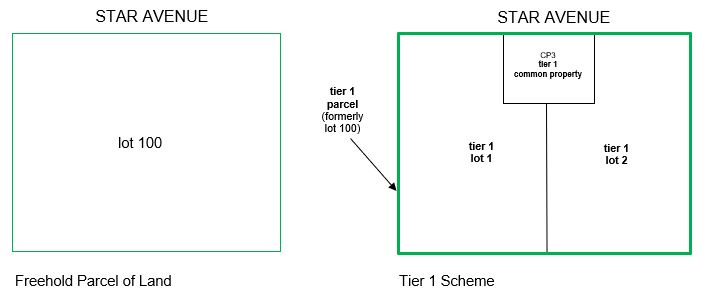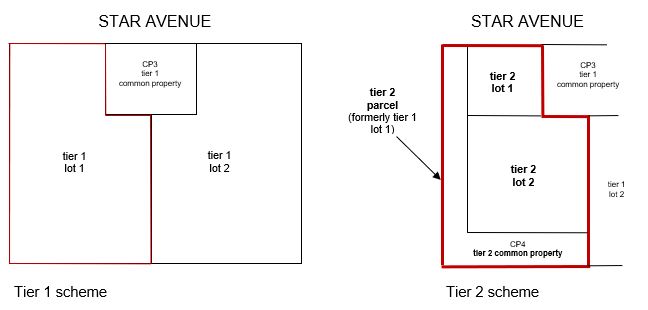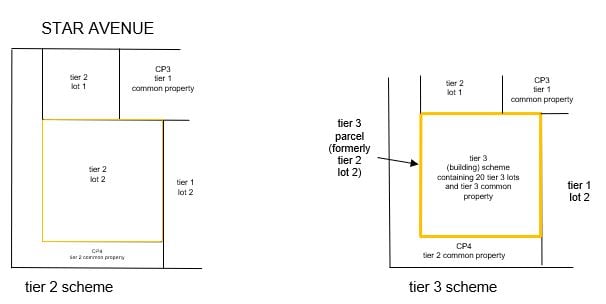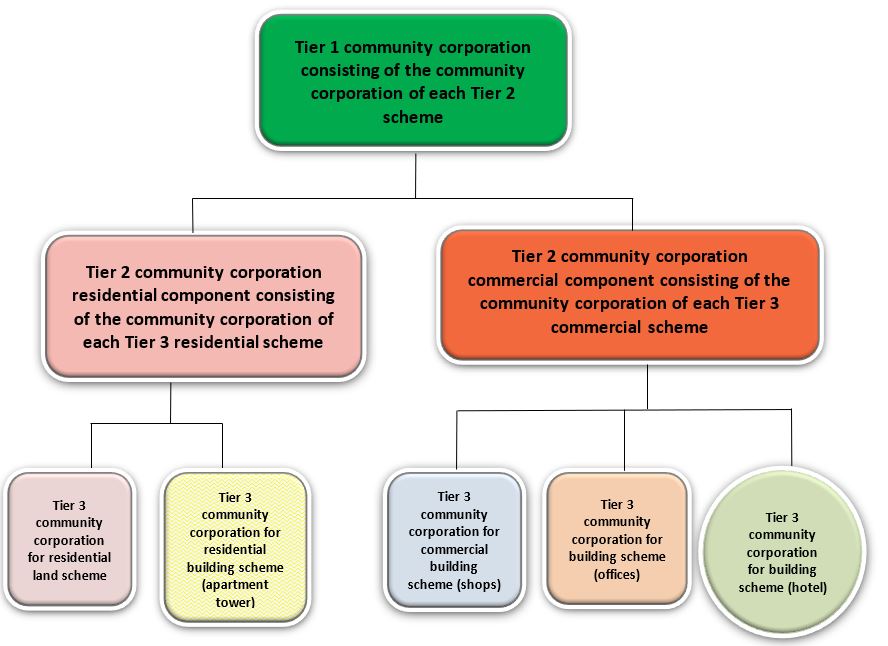The information provided in this guide is not intended to amount to legal advice. Professional assistance may be required to determine the most appropriate action to protect your legal rights. Please read our Terms of Use on the Community Titles policy and procedure guides web page. Landgate accepts no responsibility where parties print this guide and seek to rely on information that is out of date.
1. Community schemes (section 7 CTA)
The Community Titles Act 2018 (CTA) provides the legal framework for subdividing a single parcel of freehold land into a community scheme. Community schemes already exist in other states including New South Wales, South Australia and Queensland. In WA the CTA introduces new definitions, concepts, structures and processes. The CTA was passed in November 2018 and came into operation on 30 June 2021.
Community schemes do not replace strata and survey-strata schemes which still operate under the Strata Titles Act 1985. Strata and survey-strata schemes cannot be combined with community schemes. Community schemes do not include leasehold schemes.
2. Basic concepts within a community scheme
Each individual scheme within a community scheme is called a community titles scheme. A community scheme may have up to 3 tiers of community titles schemes. Every community scheme will have a community development statement (CDS) which will set out how the community scheme is to be subdivided and developed. The Western Australian Planning Commission (WAPC) will need to approve the CDS for the subject land before the land can be subdivided by a community scheme.
The land parcel over which the community scheme fits must be a whole or complete freehold land parcel i.e. it cannot be in separate portions. In some cases, a deposited plan of amalgamation of more than one parcel is the forerunner to registering a community titles scheme.
A tier 1 scheme may have its own common property which is for the whole community and which every owner of a lot in the community scheme will own as tenants in common.
A tier 2 scheme may have its own common property which the owners of lots in that tier 2 scheme and the owners of lots in a tier 3 scheme belonging to that tier 2 scheme will own as tenants in common.
A tier 3 scheme may have its own common property which is owned by the owners of lots in that tier 3 scheme as tenants in common.
2.1. Tier 1 Community Titles Scheme
The single freehold parcel of land subdivided by the tier 1 scheme (lot 100) is referred to as the tier 1 parcel.
The lots created in the tier 1 scheme are referred to as tier 1 lots 1 & 2.
The common property in the tier 1 scheme is referred to as tier 1 common property (CP3).
On registration of the scheme documents for the tier 1 scheme (i.e. scheme notice, scheme plan, schedule of unit entitlements and scheme by-laws) together with the community development statement (CDS) for the community scheme, the tier 1 community titles scheme is registered and the community scheme comes into existence.

2.2. Tier 2 Community Titles Scheme
Tier 1 lot 1 subdivided by the tier 2 scheme is referred to as the tier 2 parcel.
The lots in the tier 2 scheme are referred to as tier 2 lots 1 & 2.
The common property in a tier 2 scheme is referred to as tier 2 common property (CP4).

2.3. Tier 3 Community Titles Scheme
Tier 2 lot 2 subdivided by the tier 3 scheme is referred to as the tier 3 parcel.
The lots in the tier 3 scheme are referred to as tier 3 lots 1 to 20.
The common property in the tier 3 scheme is referred to as tier 3 common property.

2.4. Relationships in and between schemes (section 13 CTA)
- A lot or common property is in or belongs to the community titles scheme under which it is created.
- A tier 2 parcel belongs to the tier 1 scheme under which the tier 1 lot subdivided to become the tier 2 parcel is created.
- A tier 3 parcel belongs to the tier 2 scheme under which the tier 2 lot subdivided to become the tier 3 parcel is created.
- A tier 2 scheme belongs to the tier 1 scheme to which its tier 2 parcel belongs.
- A tier 3 scheme belongs to the tier 2 scheme to which its tier 3 parcel belongs and also to the tier 1 scheme to which that tier 2 scheme belongs.
- A community titles scheme is related to each community titles scheme to which it belongs or that belongs to it and the community corporations of the related schemes are related community corporations.
- The tier 1, 2 and 3 schemes that together comprise a community scheme belong to the community scheme.
When the tier 1 scheme is registered it will have a community corporation established (tier a corporation) which is the overarching management body for the entire community scheme. When each tier 2 and tier 3 scheme in the community scheme is registered, each will have its own community corporation to govern and manage relationships and common property in that community titles scheme. The community corporation for a tier 2 or tier 3 scheme will represent its members and vote on their behalf at meetings of the community corporation of the scheme to which that tier 2 or tier 3 scheme belongs.
3. Lots (section 11 CTA)
Lots in a community titles scheme are defined on the scheme plan for the community titles scheme.
A lot can be comprised of non-contiguous parts shown on the scheme plan for the community titles scheme.
3.1. Types of lots
3.1.1. Community Titles (Building) Schemes
Schemes where lots are defined as cubic space or spaces (i.e. three dimensional) referenced to a scheme (i.e. a building which is shown on a scheme plan) - See CTS-04 Scheme Plans.
- A lot in a community titles (building) scheme cannot be subdivided by a community titles scheme that is a community titles (land) scheme - CTA section 11(10).
3.1.2. Community Titles (Land) Schemes
Schemes where lots are defined by dimensions and survey information reference (in the same manner as deposited plans and survey-strata plans), regardless of whether or not there are buildings on the land. They may be restricted vertically but are generally unlimited in height and depth - CTS-04 Scheme Plans.
- A tier 1 lot or tier 2 lot in a community titles (land) scheme can be subdivided by a community titles scheme that is either a community titles (building) scheme or a community titles (land) scheme - see CTA section 11(11).
4. Common property
The common property in a community titles scheme is:
- that part of the parcel of land subdivided by the community titles scheme that does not form part of a lot in the scheme; and
- temporary common property.
All community titles (building) schemes and many community titles (land) schemes contain common property. Where plans in building schemes have incorporated all ground surface of the parcel as part of the lots and attempted to eliminate common property, the defined cubic space above or below a floor level, the subsoil and air space comprise the common property. The plan is used to record actions affecting the common property and in some cases the lots. This type of information can vary from rights and encumbrances to by-laws of the community corporation. There is no title for common property.
If a scheme plan for a building or land scheme identifies an encroachment outside the parcel that is to be controlled and managed by the community corporation for that scheme, the encroachment is to be regarded as if it were common property for that scheme.
4.1. Temporary common property (section 78 CTA)
In order to increase common property, a community corporation may, by special resolution, accept a lease of:
- a lot in the scheme or
- land that is contiguous to the tier parcel or separated only by a road, railway or waterway.
This land is known as temporary common property.
The land is not to be subject to a mortgage, charge or other encumbrance. The leasehold interest becomes common property during the term of the lease and the community corporation becomes responsible for payment of the lease and the compliance with the lease conditions.
If the lease is registered, the Registrar of Titles will place a notation on the record of community titles scheme forming part of the scheme plan to the effect that the leasehold land is part of common property for the term of the lease. If leasehold land is a portion of the contiguous land, the Registrar of Titles will require this portion to be depicted on an Interest Only Deposited Plan.
A community corporation can, in agreement with the lessor, surrender a lease of temporary common property. When the surrender is registered, notice of the surrender will be endorsed on the record of community titles scheme.
For registration details see CTS-11 Registration of an amendment of a CTS not effecting subdivision.
4.2. Lease of common property within a scheme (section 79 CTA)
For registration details see CTS-11 Registration of an amendment of a CTS not effecting subdivision.
5. Subdivision of land by community scheme (section 14 CTA)
Land is subdivided by a community scheme by registration of a community titles scheme or amendment of a community titles scheme that belongs to a community scheme. Registration of an amendment of a community titles scheme gives effect to a subdivision if it
- effects a change to the definition of a lot in the scheme; or
- effects a change to the boundary of the parcel of land subdivided by the community titles scheme; or
- effects a change to the boundary of the tier parcel of the community titles scheme.
Below are examples of the amendments of a community titles scheme that give effect to a subdivision:
- re-subdivision of lots and/or common property
- consolidation of lots
- conversion of lots into common property
- adding land to the common property and
- removing land from the common property
- changing the boundary of a tier parcel of a community titles scheme in the community scheme to which a lot or common property belongs.
For scheme plan details see CTS-08 – Amendments of Scheme Plans.
6. Registration of a community titles scheme or amendment
A community titles scheme is registered when the following scheme documents are registered:
- a scheme notice (see CTS-03);
- a scheme plan (see CTS-04);
- a schedule of unit entitlements (see CTS-05);
- scheme by-laws (CTS-06).
A registered community titles scheme is amended when amendments or replacements of the relevant scheme documents are registered.
The amendment may be necessary to give effect to a subdivision of land or it may be unrelated to a subdivision of land, comprising, for example:
- the amendment of the scheme notice to amend the name or address for service of the community corporation; or
- the amendment of the scheme plan for a purpose related to:
- an easement; or
- restrictive covenant; or
- a restricted use condition; or
- temporary common property
- the replacement of the schedule of unit entitlements for the community titles scheme because of reallocation of unit entitlements of lots or tier parcels; or
- creating, amending or repealing of scheme by-laws.
For registration details see CTS-11 Registration of an amendment of a CTS not effecting subdivision and CTS-09 Registrations on an amendment of a CTS - effecting subdivision.
7. Community titles (section 16 CTA)
The titles to the land comprised in a lot in a community titles scheme is called a community title. This title grants to the owner of the lot rights as the proprietor of a fee simple estate in the lot under the Transfer of Land Act 1893 (TLA) and a share in common property for each tier as set out below.
7.1. Tier 1 community titles scheme
A community title for a lot in a tier 1 community titles scheme includes an undivided share in the common property in that tier 1 scheme in accordance with the relative unit entitlement of that lot.
- Relative unit entitlement of a lot or tier parcel means the proportion that the unit entitlement of the lot or tier parcel bears to the sum of the unit entitlements of all the lots and tier parcels in the community titles scheme to which the lot or tier parcel belongs.
The land description on the title will be as follows:
LOT 1 ON SCHEME PLAN 80000
TOGETHER WITH A SHARE IN COMMON PROPERTY (IF ANY) IN:
TIER 1 SCHEME PLAN 80000
For example, if lot 1 on scheme plan 80000 has a unit entitlement of 1 and the aggregate of the unit entitlements for that scheme is 2, lot 1 has an undivided 1/2 share in the common property shown on tier 1 scheme plan 80000.
7.2. Tier 2 community titles scheme
A community title for a lot in a tier 2 community titles scheme includes an undivided share in the common property in that tier 2 scheme in accordance with the relative unit entitlement of that lot, together with an undivided share in the common property of the tier 1 scheme in accordance with the relative unit entitlement of the tier 2 parcel. The land description on the title will be as follows:
LOT 3 ON SCHEME PLAN 85000
TOGETHER WITH A SHARE IN COMMON PROPERTY (IF ANY) IN:
TIER 2 SCHEME PLAN 85000 AND
TIER 1 SCHEME PLAN 80000
Lot 3’s undivided share in the common property of each tier is:
for the tier 2 scheme, its relative unit entitlement in the tier 2 scheme.
for the tier 1 scheme, this is determined by multiplying:
- the relative unit entitlement of lot 3 and
- the relative unit entitlement of lot 3’s tier 2 parcel.
For example, if lot 3 on scheme plan 85000 has a unit entitlement of 1 and the aggregate unit entitlements for that scheme is 3, lot 3 has a 1/3rd share in the common property shown on tier 2 scheme plan 85000 and a 1/6th share (1/3 multiplied by 1/2) in the common property shown on tier 1 scheme plan 80000.
7.3. Tier 3 community titles scheme
A community title for a lot in a tier 3 community titles scheme includes an undivided share in the common property in that tier 3 scheme in accordance with the relative unit entitlement of that lot, together with an undivided share in the common property of the tier 2 scheme to which that tier 3 scheme belongs in accordance with the relative unit entitlement of the tier 3 parcel, together also with an undivided share in the common property of the tier 1 scheme to which the tier 2 scheme belongs in accordance with the relative unit entitlement of the tier 2 parcel. The land description on the title will be as follows:
LOT 7 ON SCHEME PLAN 90000
TOGETHER WITH A SHARE IN COMMON PROPERTY (IF ANY) IN:
TIER 3 SCHEME PLAN 90000 AND
TIER 2 SCHEME PLAN 85000 AND
TIER 1 SCHEME PLAN 80000.
Lot 7’s undivided share in the common property of each tier is:
for the tier 3 scheme, its relative unit entitlement in the tier 3 scheme.
for the tier 2 scheme, this is determined by multiplying:
- the relative unit entitlement of lot 7; and
- the relative unit entitlement of lot 7’s tier 3 parcel.
for the tier 1 scheme, this is determined by multiplying:
- the relative unit entitlement of lot 7; and
- the relative unit entitlement of lot 7’s tier 3 parcel; and
- the relative unit entitlement of the tier 2 parcel to which the lot 7’s tier 3 scheme belongs.
For example, if lot 7 on scheme plan 90000 has a unit entitlement of 1 and the aggregate unit entitlements for that scheme is 10, lot 7 has a 1/10th share in the common property shown on tier 3 scheme plan 90000, a 1/30th share in the common property (1/10 multiplied by 1/3) shown on tier 2 scheme plan 85000 and a 1/60th share (1/10 multiplied by 1/3 multiplied by 1/2) in the common property shown on tier 1 scheme plan 80000.
Similar to a strata title, a community title contains an interests notation under the Limitations, Interests, Encumbrances and Notifications heading referring to interests notified on the scheme plan. This means there could be other interests not recorded on the title that may benefit or encumber the common property or lot. Therefore, a community title must always be searched in conjunction with the scheme plan.
8. Community corporation
On registration of a community titles scheme, a community corporation is established for that scheme.
The name and address for service of the community corporation is as provided in the scheme notice.
A community corporation:
- is a body corporate; and
- has perpetual succession; and
- is capable of suing and being sued in its own name; and
- has, subject to this Act, all the powers of a natural person that are capable of being exercised by a body corporate.
The governing body of a community corporation is a council established under section 111 CTA. A community corporation may have a common seal, but this is optional.
A tier 1 corporation is comprised of the following members:
- the owners, for the time being, of the tier 1 lots;
- for each tier 2 parcel belonging to the tier 1 scheme, the tier 2 corporation.
A tier 2 corporation is comprised of the following members:
- the owners, for the time being, of the tier 2 lots;
- for each tier 3 parcel belonging to the tier 2 scheme, the tier 3 corporation.
A tier 3 corporation is comprised of the owners, for the time being, of the tier 3 lots.
Example
